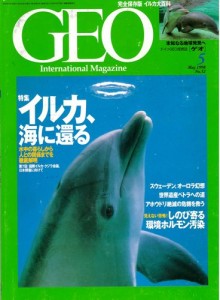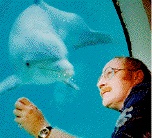Click here to add your own text
Dr. Ken Marten on being a U.S. tunaboat observer:
TESTIMONY OF DR. KEN MARTEN,
FORMER NATIONAL MARINE FISHERIES SERVICE
PORPOISE OBSERVER,
AND DOLPHIN RESEARCH BIOLOGIST
I have served as a National Marine Fisheries Service porpoise observer
on tuna boats, and have conducted research on dolphin behavior for 14 years.*
I have witnessed and taken detailed data on hundreds of purse-seine
sets on dolphins. My conclusions are as follows:
1. CONSEQUENCES OF SETTING TUNA PURSE SEINE NETS
ON DOLPHINS
With the current technology, if purse seine nets are set on
dolphins, dolphins will be killed in large numbers. One tuna boat has the
potential to kill more than 5,000 dolphins in a single day. I have witnessed
many large kills myself, and in fact when the dead dolphins came up in the
net as it was brought in, there were no tuna! (And the dolphins were Eastern
Spinners, considered at that time to be dangerously depleted and illegal to set
nets on.)
Large kills of 5,000 or more in a single net set would be most
likely in the case of equipment failure that take the set into the night, when
the dolphins, probably deafened by the bombs used to prevent them from
escaping out of the net, and thus probably lacking sonar, get entangled by
large folds in the net that the fishermen, who can’t see and whose equipment
has failed, can no longer control.
In my experience, such equipment breakdowns and night-time
problems were common and almost always resulted in all of the dolphins in
the net dying — and thousands of dolphins can be in the net (And this can
occur even if the set started in the morning.) Also, it was during massive
kills of this type that the fishermen used the same bombs that they use on the dolphins to
keep me from counting and reporting the dead dolphins — and indeed they
deafened me for approximately 24 hours.
2. OBSERVER PROGRAMS
If it is decided that tuna nets are to be set on dolphins rather
than tuna, and large numbers of dolphin lives are sacrificed as a consequence,
it is unrealistic to expect an observer program like the one already in
existence to accurately count and report the number of dead dolphins. A quota,
therefore, has no meaning. An observer program can count and record dead
dolphins accurately only if observers have powers of enforcement. That is,
only if they themselves can cite tuna boats and their captains for unlawful
conduct. Having been criminally assaulted myself, repeatedly, as a government
observer (a captain could demand to see counts), my experience was that high
counts lead to powerful coercive behavior (and a captain has total power on
his boat), and reporting the true kill is virtually impossible. My own experience
leads me to believe that observer reports are probably only a small fraction of
the true kill. And I suspect that this disparity is even worse outside of the
United States.
3. THE SHOOTING OF DOLPHINS AND WHALES
The common practice of getting out the firearms on a boat and
shooting all of the rough-toothed dolphins, pilot whales, and false killer
whales in the area before setting the nets on a log for skipjack tuna should
be banned and enforced.
4. MORAL CONSIDERATIONS
People have speculated for decades that the massive extermination
of dolphins by the tuna industry might be an immoral act perpetrated on some
kind of social, conscious beings. My research on self-awareness in the
bottlenose dolphin for the last six years confirms that such a fear does
indeed have a scientific basis. An important objective measure of
consciousness is what scientists call Rself-awarennessS, which involves having
a concept of self so that, for example, a person or animal can tell that its
mirror image is itself and not another individual. Only man and the great
apes were thought to posess it. The conclusion of my research is that
bottlenose dolphins also appear to belong to this exclusive group of
creatures whose consciousness has evolved to the level of Rself-awarenessS
(Marten and Psarakos, 1994; Marten and Psarakos, 1995a; Marten and Psarakos,
1995b; Marten et al., 1996).
5. SOLUTION
Although the problem is complex, the solution is disarmingly
simple:
the only way to get rid of the high mortality of dolphins in the tuna industry is to set tuna nets on tuna, not dolphins.
*The 14 years of research referred to at the beginning consisted of 1 1/2
years at the Naval Ocean Systems Center, 6 years on the faculty at the
University of California at Santa Cruz, and 6 1/2 years at my own laboratory
at Sea Life Park, Hawaii.
References
Ken Marten and Suchi Psarakos, 1994. Evidence of Self-Awareness in
the Bottlenose Dolphin (Tursiops truncatus). In: Self-Awareness in Animals
and Humans. Cambridge University Press, pp. 361-379.
Ken Marten and Suchi Psarakos, 1995a. Using Self-View Television to
Distinguish Between Self-Examination and Social Behavior in the Bottlenose
Dolphin (Tursiops truncatus). Journal of Consciousness and Cognition, vol. 4, no. 2, pp. 205-224.
Ken Marten and Suchi Psarakos, 1995b. Marten and Psarakos Commentary
Response. Journal of Consciousness and Cognition, vol. 4, no. 2, pp. 258-269.
Ken Marten, Karim Shariff , Suchi Psarakos, and Don J. White. 1996.
Ring Bubbles of Dolphins. Scientific American. August 1996, pp. 82-87.


